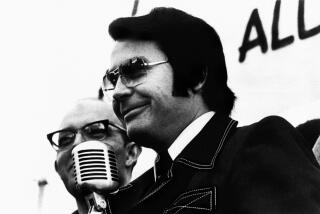The Competition for the Purest Link to the Divine
If you had asked the man on the street in 1900 about the future of religion, he would have said its days were numbered. One of the more surprising developments of the 20th century is that, far from receding from public life, religion has entered it in new and challenging ways.
Nietzsche famously announced that God was dead, but in the Western world, millions would disagree. Those who wish to do God’s will have struggled mightily against those who have little time or patience with faith, and they have struggled as well with others who see their God in a different light.
The three great monotheistic traditions of the West--Judaism, Christianity and Islam--worship the same God but have competed over who has the purest link to the divine. These struggles, between these faiths and within them, is the subject of Karen Armstrong’s sometimes dense, always informative and illuminating new book, “The Battle for God.”
Armstrong, a former nun and the author of several books on religion, traces the history of fundamentalist movements from the 15th century to the present. She sees the rise of the modern world as a dramatic transformation in human existence, and she believes the central issue has been the unresolved tension between mythos and logos.
Mythos concerns the spiritual, where dreams, myths, superstition and faith reside. Logos is the realm of science, of the mind, order, government and logic. As the modern world evolved, Armstrong writes, logos triumphed at the expense of mythos, science at the expense of religion. But not all human yearnings were satisfied by logos, and hence the rise of fundamentalism.
Armstrong believes that an understanding of contemporary fundamentalist movements requires some sense of how the devotees of faith have evolved over the last few centuries. Her narrative tells of the 17th century Jewish pseudo-messiah Shabbetai Zevi, the increased importance of the mystical cabala, the growth of the Hasidim in 18th century Russia, the yeshiva movement and finally the rise of Zionism, which created a fissure within Judaism between those who wanted to create a secular state and those who believed that a Jewish return to Palestine was a fulfillment of biblical prophecy.
She describes the rise of state Islam in the Ottoman and Persian empires during the 17th and 18th centuries, and the 19th century attempts of Muslim nations, Egypt especially, to face the military and cultural challenge of Europe. She traces the rise of Islamic fundamentalism to the inability of the Muslim states of the Middle East to compete with the West militarily or economically. And she charts the peregrinations of Protestant fundamentalists in the United States, who have waged a rear guard campaign against the secularization of American society for much of the 20th century.
The last third of the book covers the more familiar fundamentalist movements of recent years, including the Ayatollah Khomeini and the Islamic Revolution in Iran, the battle between the ultra-Orthodox and the secular government in Israel and the attempts of the Moral Majority and other groups to dictate the social agenda of the U.S. government.
She believes that, having crested in the late 1970s and early 1980s, fundamentalist movements are on the retreat, facing defeat because they forgot to focus on the spiritual and instead descended in “an ideology of exclusion, hatred and even violence.”
Not a great stylist, Armstrong is an opinionated writer, and she is not shy about passing judgment. She criticizes the 19th century itinerant reformer Jamal al-Din al-Afghani for not recognizing his inconsistencies; she lambastes the reductive theology of Rabbi Meir Kahane; and she claims that Jerry Falwell and Pat Robertson are dominated by “a paranoid fear of annihilation and destruction.”
At the same time, she is clearly sympathetic to mythos, and she recognizes that secular rationalism and materialism don’t satisfy all human needs. True to her own past as a nun, she respects the genuine dissatisfaction that many people feel toward the cold, scientific rationalism that seems to prevail in the modern world.
And while she sheds no tears for the defeat of those who use terror and violence in the name of God, she also has some stern words for those who might celebrate that defeat.
“The battle for God,” she concludes, “was an attempt to fill the void at the heart of a society based on scientific rationalism. Instead of reviling fundamentalists, the secularist establishment could sometimes have benefited from a long, hard look” at itself.
All of us, she asserts, need to confront the fears generated by the modern world, and if the dominant culture fails to do so, others, such as fundamentalists, will. That is a key message, one that is easily drowned out in contemporary society, with only occasional voices like Armstrong’s reminding us that we forget it at our peril.
More to Read
Sign up for our Book Club newsletter
Get the latest news, events and more from the Los Angeles Times Book Club, and help us get L.A. reading and talking.
You may occasionally receive promotional content from the Los Angeles Times.








